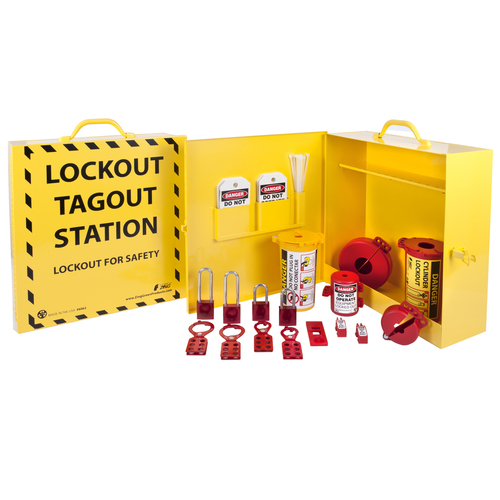Lockout Device Buying Guide
Posted on

Buying lockout devices can be a stressful process. You want to be sure that:
- all potential energy hazards in your workplace are accounted for.
- workers are protected with high-quality, reliable devices.
- workers are comfortable using the devices supplied to them.
This guide will help make your decision easier. We will cover:
- Identifying energy sources
- Types of devices
- General lockout requirements
Types of Energy
The first step is to make a list of all potentially dangerous energy sources in your workplace. There are many types hazardous energy. Some of the most common energy types are listed below.
Electrical energy is the most common energy source. Many machines and workplace vehicles require electricity to run. Unwanted energization of equipment and electrical shock may occur if electrical sources are not properly locked out.
Chemical energy is result of a chemical reaction. Chemical energy may generate extreme heat or explosive reactions.
Hydraulic and Pneumatic energy is stored in pressurized liquid and air, respectively. Residual energy may still be present in a machine even after the relevant valves have been locked out, so it is important to make sure all energy has been carefully drained during the lockout process.
Mechanical energy refers to objects under tension, such as a springs or coils.
Once all energy sources are located, it is important to form a list of how the energy is initiated, whether through valve handles, switches, buttons, or plugs. This information will help you choose the most appropriate lockout devices.
OSHA’s Device Requirements
OSHA standard 1910.147 sets forth the following requirements:
- Lockout devices must be able to withstand workplace conditions.
- Devices must be standardized according to color, shape or size.
- Devices must indicate the identity of the employee who placed it.
In other words, lockout devices have to be dependable and easily identifiable. Devices should be tested before use in a real lockout situation, to ensure they work as they are designed to. Standardization and personalization help identify the purpose of the device, and firmly establish the identity of the person who can place or remove a given device.
Types of Lockout Devices
Lockout devices work by immobilizing energy sources, so that they cannot be turned on. Devices are usually locked into place with a safety padlock, so that only the worker who placed the lockout can remove it.
Hasp
Hasps isolate energy sources and hold multiple padlocks, which ensures the device cannot be energized until all workers have removed their padlocks. This is especially important in group lockout situations.
Plug Lockout
A plug lockout encloses the prong-end of a plug, making it impossible to insert into a power source. The device must be large enough to completely enclose the plug.
Circuit Breaker Lockout
Circuit breaker lockouts lock circuit breakers in the OFF position. Many devices snap or clamp into place. It is important to select the correct size; the switch should be completely secure while the lockout is applied.
Valve Lockouts
Valve lockouts are used to prevent valve-operated machinery from being energized. There are 3 common types of valve lockouts:
A Gate-Valve Lockout encloses a gate valve handle, so that it is impossible to turn. The lockout must be able to rotate freely around the handle.
A Ball Valve lockout locks out energy-carrying pipes by immobilizing the valve handles.
A Butterfly Valve lockout slides onto a butterfly valve, clamps into place, and locks the valve in the OFF position.
Push Button Lockout
Push button lockouts cover buttons commonly found on electrical panels and some machines, so that the buttons cannot be pressed.
Cable Lockout
Cable lockouts work in several lockout applications, and are usually used when handles, levers, or switches are difficult to reach, or when other devices are not applicable. The cable around the relevant valve handle or switch, which is then locked into place with a lockout padlock. Some devices include a cinching or squeezing component which allows the cable to be easily locked as tightly as possible.

Organizational Tools
Lockout Stations:
Stations provide a centralized, organizational tool for storing lockout devices, which makes it easier for workers to find the right device for a given job. The convenience and visibility of stations also encourages use. If a workplace is large, several stations may be necessary.
Lockout Kits:
Lockout kits emphasize portability. Usually in pouch or toolbox formats, lockout kits store a variety of devices, locks, and tags. Kits are an excellent choice if workers have to work on multiple job sites, or lock out several machines. Kits also help workers have the proper lockout devices at their disposal, whenever they need them.
Group Lockout Boxes:
Group Lockout Boxes are an important group lockout tool. Keys to lockout devices or disconnect master keys are placed inside of the group lockout box. Then each worker involved in the group lockout attaches his or her personal lock to the lockout box. This ensures the lockouts can only be removed after each employee has removed their lock from the box.
Training
Workers must understand how each device they use works. If introducing new devices, workers must be trained to use the new devices properly.
 Loading... Please wait...
Loading... Please wait...
